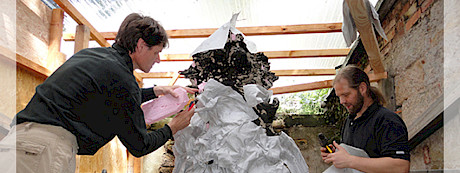Application of Ethyl Silicate Based Consolidants on Sandstone with Partial Vacuum: A Laboratory Study
06/09/2016 - 10/09/2016By H. Siedel, J. Wichert and T. Frühwirt
Abstract
To improve the penetration depth of a TEOS consolidant on Cotta sandstone with high amount of small voids and clay mineral content, the so-called “Vacuum Circulation Process” (VCP) was applied to test cubes of fresh sandstone. Changes of mechanical and hydric properties were determined on drill core profiles across the test cubes after a 4 month reaction time. Especially for Remmers Funcosil 300E, the results show a significantly higher penetration depth compared to a reference cube brushed by hand with the same agent. Moreover, biaxial flexural strength and Young’s modulus profiles for Funcosil 300E / VCP are acceptable in terms of the relation of both properties and their change along the profile line from surface to the interior. Hydric properties show a still slightly hydrophobic reaction of the penetrated outermost zone. Although these results encourage the use of VCP also for building stones with a high amount of smaller voids, the role of the partial vacuum during the process remains unclear, since similar penetration depths were reached by total immersion of a sandstone cube under atmospheric pressure.
1. Introduction
Inappropriate penetration depths of stone consolidants are a common problem especially for the treatment of building sandstones with a higher amount of smaller voids and clay mineral contents. In restoration practice, the so-called “vacuum circulation process” (VCP, Pummer 2008) has been occasionally used for consolidation treatments of small objects like sculptures to reach better penetration of the consolidant. For this treatment, the entire stone object is sealed in a tight plastic foil bag which is “evacuated” by partial vacuum down to - 900 mbar (g). Maintaining the partial vacuum, fluid tetra ethyl ester of the orthosilicic acid (TEOS) is subsequently sucked in the bag with the object via valves in the foil skin. Although there are only few systematic investigations on the change of physical properties after VCP treatment, it seems to work well in practice with respect to the penetration depth especially for stone varieties with coarse voids. However, conservation issues often concern sandstones with higher amounts of smaller voids and clay contents which are on one hand susceptible to weathering and on the other hand hard to penetrate for liquids. The study aimed at testing the VCP treatment for clay mineral bearing building sandstone with low average pore diameter. For the tests Elbe Sandstone (Cotta type) from the region of Saxony (Germany) with median pore diameter D50 of 1.4 µm was chosen (see Fig. 1 and Fig. 2). The problem of low penetration depths of consolidants is well known from several conservation measures on this material.
2. Materials and methods
2.1. Cotta sandstone
Cotta sandstone is a building stone from the Upper Cretaceous (Turonian) quarried in the Elbe Valley some 20 km south of the city of Dresden since the 15th century. The fine to medium grained quartz arenite (Fig. 1) contains clay minerals like kaolinite and illite and has a broad pore size distribution shown in Fig. 2.
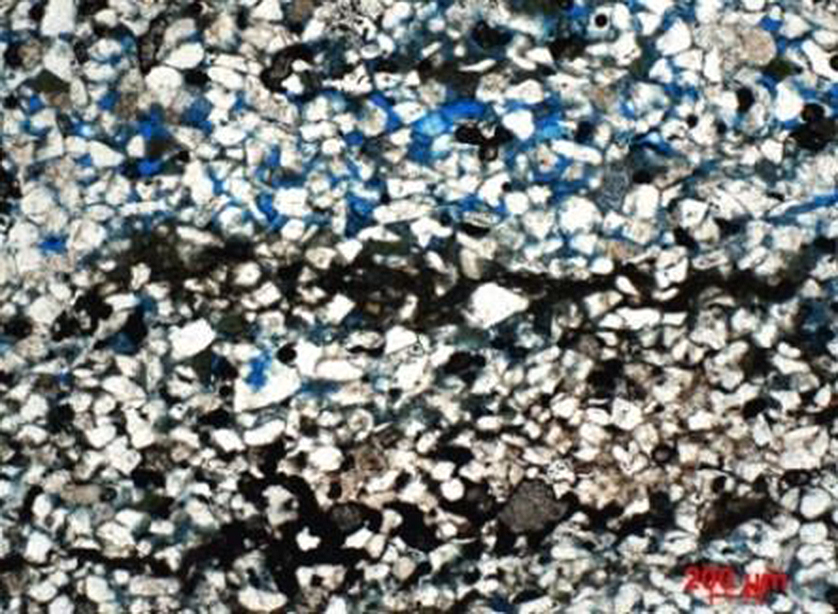
Fig. 1: Thin section image of Cotta sandstone (Nicols II) with light quartz grains and dark clay mineral layers
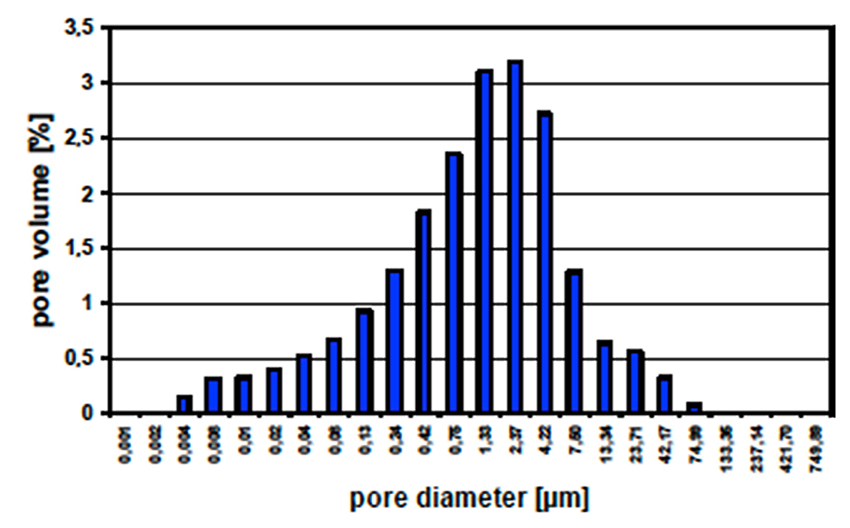
Fig. 2: Pore size distribution of Cotta sandstone used for the tests (U), according to MIP. Total porosity of this sample is 20.6 %.
2.2. Samples and treatment with VCP
Test cubes of 20x20x20 cm were cut from Cotta type sandstone from the quarry Lohmgrund II, Sächsische Sandsteinwerke GmbH. The chosen format represents the thickness of smaller objects such as tombstones or parts of sculptures. In the restorer’s workshop (Erich Pummer, Rossatz / Wachau, Austria) the cubes were air dried, sealed in foil bags and treated with TEOS systems with “soft segments” (polyether chains, Snethlage 2014) and different SiO2 gel “content” (Remmers Funcosil 300E, pre-condensed Remmers Funcosil 500E) applying the VCP. The TEOS systems contained an (unknown) reaction accelerator designed by Remmers for the use in VCP. Treatment duration was 6-7 hours for Funcosil 500E and 8 hours for Funcosil 300E; with a TEOS consumption of 5.2 and 3.4-5.2 litres, respectively. As reference additional test cubes were treated in a conventional way by brushing the liquid (Funcosil 300E without reaction accelerator) several times “wet-in-wet” on the surface until the stone surface was visibly saturated. To compare the penetration depth reached by applying partial vacuum to that reached by embedding the same stone in the liquid under atmospheric pressure, another cube was stored in Funcosil 300E for 6 hours (TEOS consumption 2.7 litres) and cut immediately afterwards.
After the treatment, all sample cubes were stored 4 months at 65 % RH / 21°C.,Subsequently, 8 drill cores were taken from every cube normal and parallel to bedding,planes of the sandstone, respectively.
2.3. Investigation of physical properties
Drill cores taken from the test cubes were cut into 5 mm thick discs normal to the cylinder axis to obtain profiles from the surface to the depth. Before cutting the cores, measurements of the ultrasonic wave velocity (UWV, air-dried condition) had been performed stepwise, in two orthogonal directions normal to the cylinder axis, with a GEOTRON system. In a first step, hydric properties (total water uptake, hydric swelling, and water vapour diffusion) of the discs were determined by non-destructive measurements, followed by destructive measurements in order to obtain mechanical properties (Siedel and Siegesmund 2014).
2.3.1. Hydric swelling and total water uptake
The air dry samples were fixed in a sample holder (Invar) combined with dilatometer (precision 0.01 mm) and immersed in demineralised water for 96 h. The maximum swelling value [mm/m] was registered. Before immersion and after water storing, the samples were weighed and the mass difference was compared with the dry sample mass [wt.-%].
2.3.2. Water vapour diffusion resistance
Water vapour diffusion was measured following EN-ISO 12572 in the “wet cup” conditioning (96 vs. 50 % RH, 21°C). From the mass difference over time, the water vapor resistance value (µ) was calculated. This parameter indicates how many times the resistance of a material against streaming water vapour is higher compared to a layer of pure air of the same thickness.
2.3.3. Biaxial flexural strength and Young’s modulus
Biaxial flexural strength (BFS) and Young’s modulus (YM) were determined on each disc, with the circular disc resting upon a larger ring while pressure is being applied centrically by a second smaller ring, according to the method described by Kozub (2008).
3. Results and discussion
3.1. Penetration depth
The penetration depth of the liquid consolidant was assessed by cutting two control cubes immediately after treatment with VCP and Funcosil 300E. Moreover, another test cube was cut after full immersion in Funcosil 300E under atmospheric pressure. The results are displayed in Fig. 3 and Fig. 4. They show, that the maximum penetration depths vary between 2.5 and 5 cm for two different cubes of Cotta sandstone treated with VCP under the same conditions (-200 to -500 mbar (g)) and do not differ significantly from those observed on the cube immersed in Funcosil 300E under atmospheric pressure (maximum 3 cm). As can be seen in Fig. 4 (below), penetration depth along bedding planes of the sandstone is slightly higher than normal to bedding.
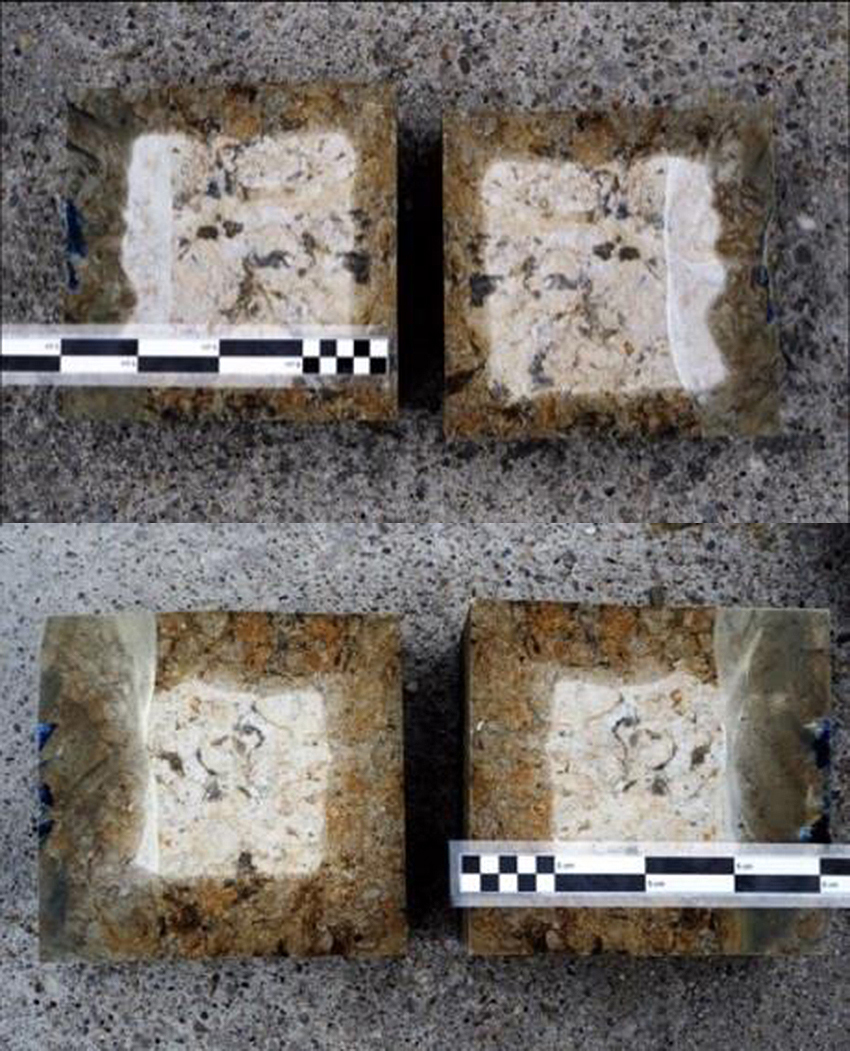
Fig. 3: Test cubes penetrated by Funcosil 300E with VCP and cut parallel to bedding immediately after the procedure (photos: E. Pummer).
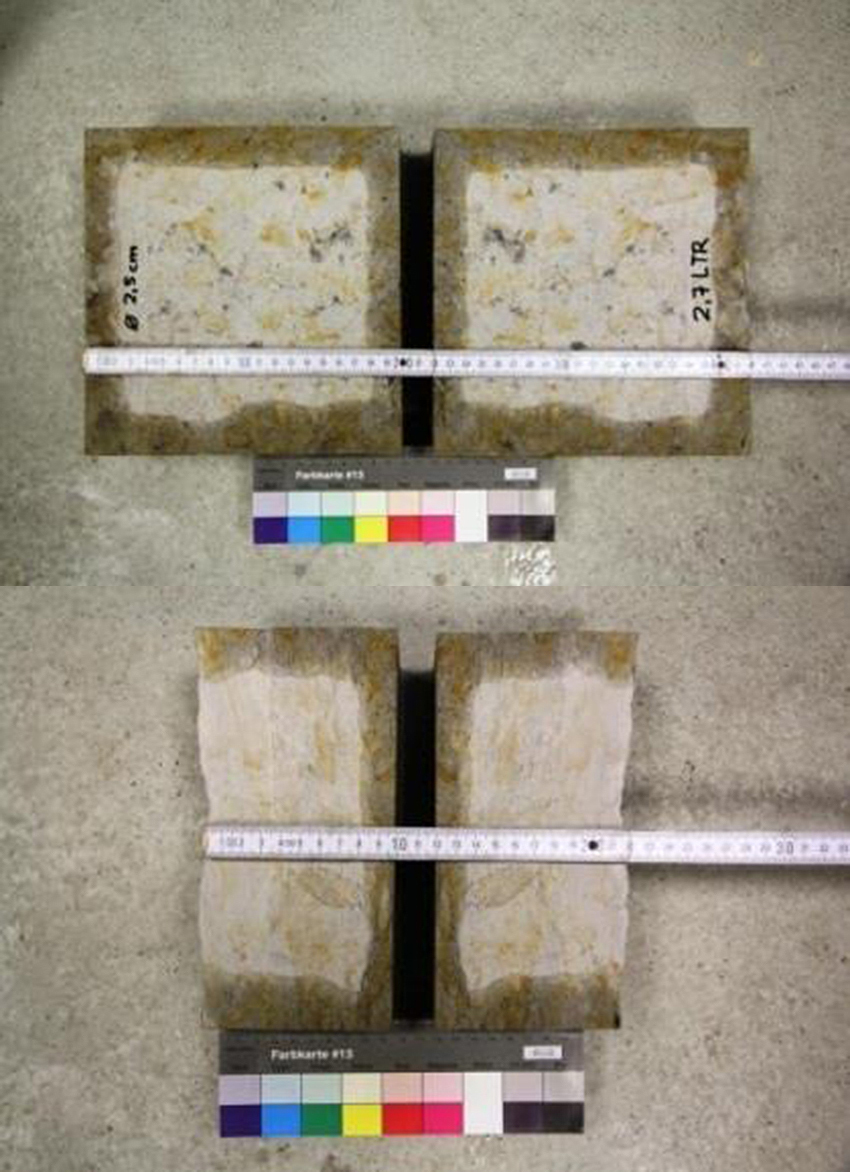
Fig. 4: Test cube penetrated by Funcosil 300E with total immersion under atmospheric pressure and cut parallel (above) and normal to bedding (below) immediately after the procedure (photos: M. Eilenberger).
3.2. Ultrasonic wave velocity
Fig. 5 displays the average values of all UWV profiles measured for the differently treated samples as well as for the untreated cube after 4 month of storage. The differences of UWV in the cores of the different sample cubes (deeper than 50-60 mm from surface) give the range of natural scattering in Cotta sandstone. As can be seen from the graphs, the hand-treated cube (E) shows the lowest change of UWV of all samples with effects limited to the first 10 mm from surface. Samples treated with VCP clearly show deeper and stronger effects (up to about 50 mm in case of Funcosil 300E (P) and about 30 mm in case of Funcosil 500E (K)). In contrast to the steep slope of the profiles of E and K in the outermost zone, the cube P treated with VCP and Funcosil 300E shows a more smooth profile. The profiles obtained from measurements in two different directions, both normal to the axis of the cores, are highly consistent.
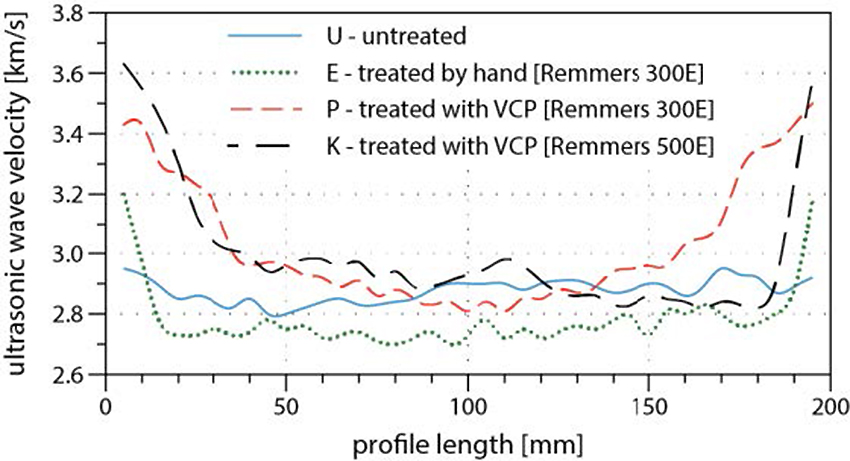
Fig. 5: Ultrasonic wave velocity profiles across the test cubes (average values for all measurements on drill cores).
3.3. Biaxial flexural strength and Young’s modulus
Changes in BFS and YM profiles for all samples after the treatment displayed in Fig. 6 and Fig. 7 reflect the changes in UWV (cf. Fig. 5).
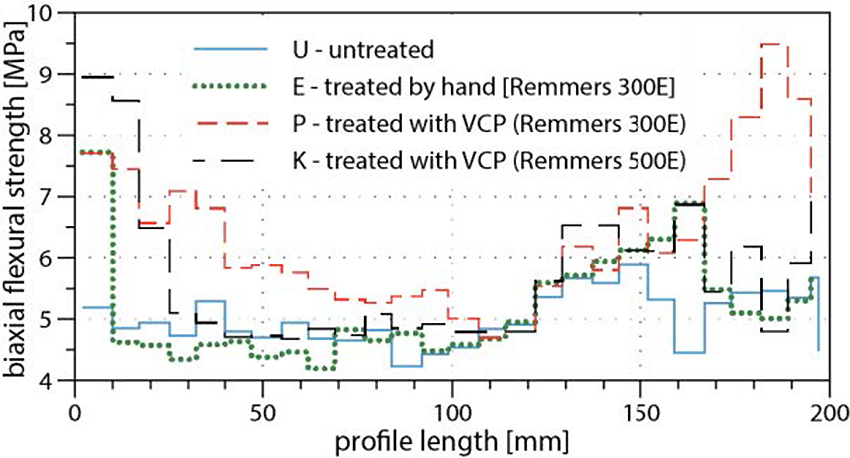
Fig. 6: Biaxial flexural strength profiles across the test cubes (average values for all measurements on 5 mm discs cut from drill cores).
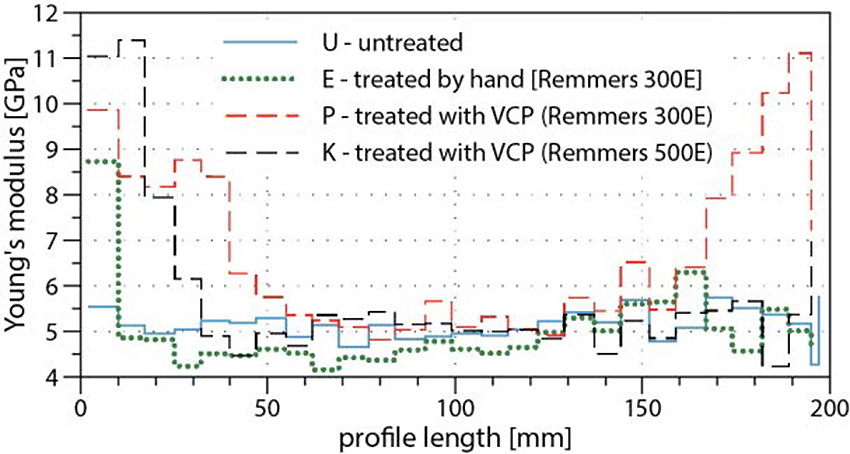
Fig. 7: Young’s modulus profiles across the test cubes (average values for all measurements on 5 mm slices cut from drill cores).
The profiles show steep slopes of BFS and YM from the surface to the interior in case of the hand-treated cube E and the cube K treated with VCP and the pre-condensed consolidant Funcosil 500E, respectively, whereas cube P treated with Remmers 300E and VCP shows a more gradual decrease of the values for both parameters. According to Snethlage (2014), the evolution of YM and BFS values per distance from the surface in a profile, the relative increase in YM and BFS achieved through treatment as well as the relation between YM and BFS are crucial criteria to avoid delamination of the stone surface by “over- strengthening” the surface layer. Regarding the change of YM (less than or equal to 1 GPa/mm) and BFS (less than or equal to 0.2 MPa/mm) from surface to the interior, the changes observed in the profile after treatment with Funcosil 300E and VCP are within the limits established by Snethlage 2014 (cf. Fig. 6 and Fig. 7). Although the changes in YM and BFS for cube P, compared to YM and BFS of its untreated inner core, are slightly over the limit in the outermost zone (changes must be less than or equal to 50 % according to Snethlage 2015), the results are generally satisfying with that respect. Discussing these parameters, one has to keep in mind that, in contrast to the hand-treated cube E, the impregnation depth reached by VCP in case of cube P is much higher. Mechanical stresses affecting the stone material e.g. due to moisture load from the surface will not reach deeper than a few millimetres, as indicated by the relatively low capillary water uptake coefficient of fresh Cotta sandstone 1.5-2 kg/m2h0.5). The relation between YM and BFS displayed in Fig. 8 shows a slight increase towards the surface penetrated by the consolidant for the VCP-treated samples. Due to the strong scattering of this coefficient even in untreated stone material this has to be discussed with some care. All in all, however, the results obtained for mechanical parameters are acceptable in case of VCP with Funcosil 300E.
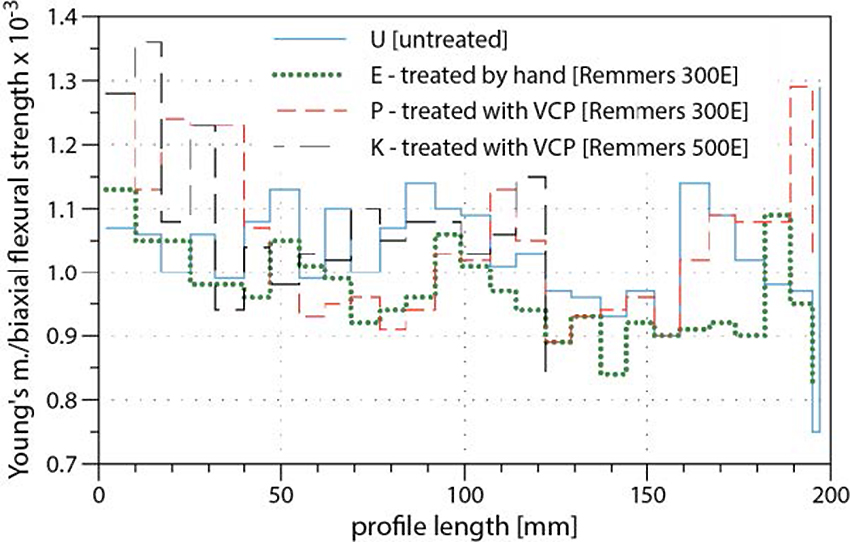
Fig. 8: Relation between Young’s modulus and biaxial flexural strength along profiles across the test cubes (average values for all measurements on 5 mm discs cut from drill cores).
3.4. Hydric properties
The results obtained for total water uptake and hydric swelling are displayed in Fig. 9 and Fig. 10. The results for water vapour diffusion resistance can be found in Fig. 11. As can be seen from Fig. 9 and Fig. 11, water uptake is reduced in the impregnated zones, whereas diffusion resistance has increased. The investigation of the pore size distribution of the impregnated and the non-impregnated zones by mercury intrusion porosimetry (Wichert et al. 2015) has shown that there is no significant change in pore volumes in the diameter range between 0.1 and 100 µm, which is responsible for capillary transport. Thus, the decreased water uptake and the increased diffusion resistance might be explained by a slightly hydrophobic state of the outermost impregnated zones (i.e. the reaction of TEOS to silica gel is still incomplete after 4 months because the humidity during setting the gel obviously was too low). Testing with water droplets on the surface of the cubes confirmed this assumption. Although changes are higher than demanded by Snethlage 2014 (less than or equal to 20 %), they should be reduced in future with further reaction of the consolidant. Measurements of hydric dilatation (Fig. 10) did not show significant changes due to the impregnation.
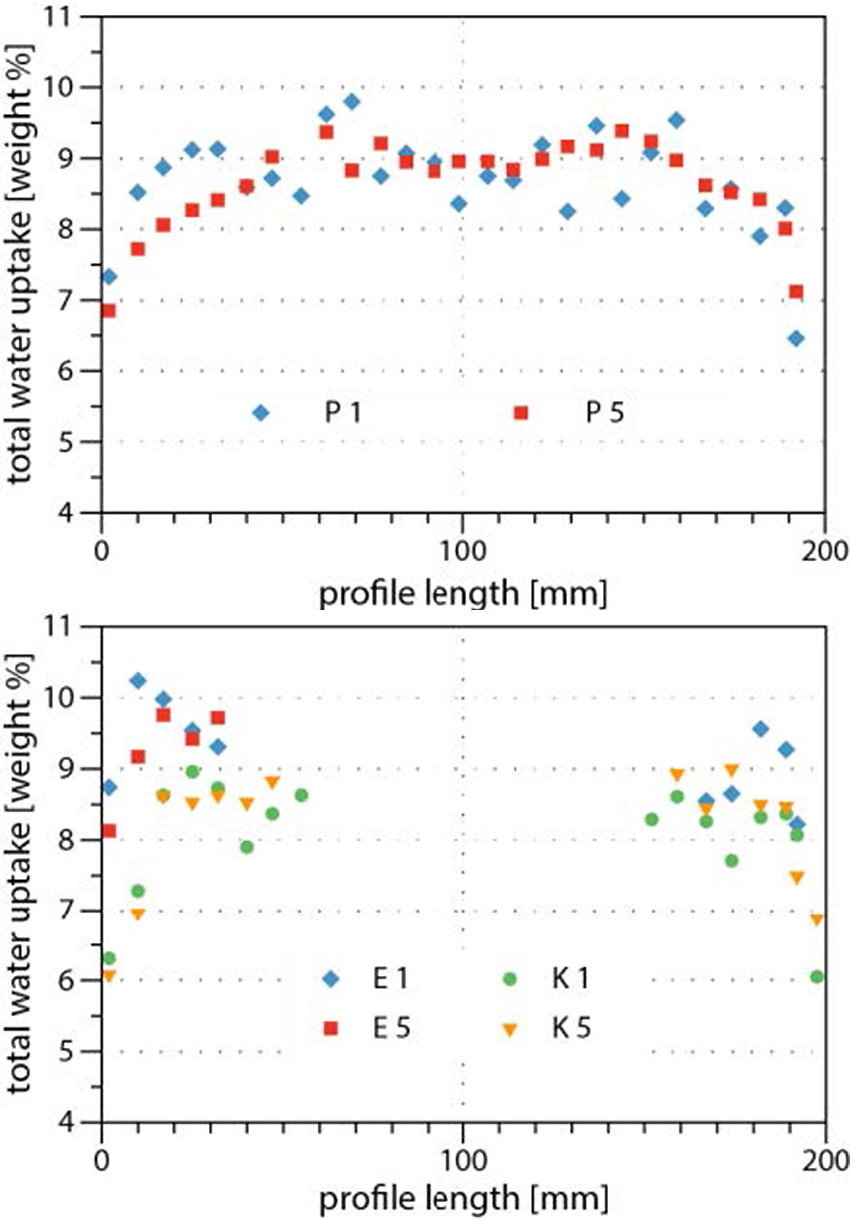
Fig. 9: Total water uptake profiles across the test cubes (measurements on 5 mm discs cut from drill cores; the discs from the inner core were not measured for cubes E and K).
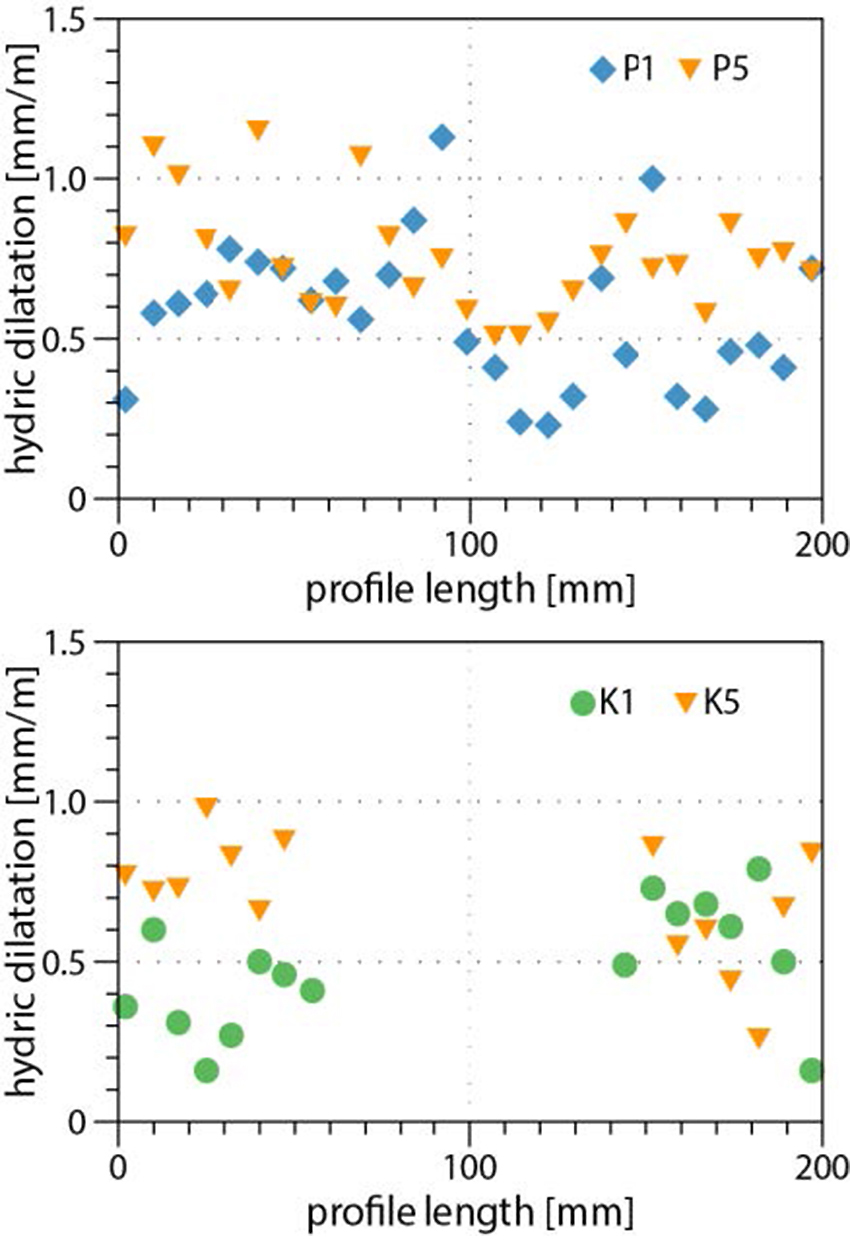
Fig. 10: Hydric dilatation profiles across the test cubes P and K (measurements on 5 mm discs cut from drill cores; 1 parallel, 5 normal to bedding). Discs from the inner core were not measured for cube K.

Fig. 11: Water vapour diffusion resistance profiles across the test cubes (measurements on 5 mm discs cut from drill cores; 1 normal, 5 parallel to bedding). The discs from the inner core were not measured for cubes E and K.
4. Conclusions
Treatments of test cubes made of Cotta sandstone with TEOS Funcosil 300E by hand and with Funcosil 300E and 500E by VCP showed significantly higher penetration depths for the VCP impregnated cubes. According to measurements of mechanical and hydric properties on drill core profiles taken from the test cubes, the obtained spatial distribution of BFS and YM are satisfying in case of Funcosil 300E and VCP, whereas the cubes treated with Funcosil 500E (VCP) and 300E (by hand) show steep decreases of both values from surface to the interior, which might be harmful with respect to delamination due to over strengthening. However, the impregnated zones of all cubes are slightly hydrophobic, indicating a still incomplete reaction of TEOS after more than 4 months. Although these results in principle encourage the use of VCP in practice also for building stones with a high amount of smaller voids, the role of partial vacuum during the process still remains unclear, since similar penetration depths were reached by total immersion of a sandstone cube under atmospheric pressure only by capillary suction. Due to the expectable wide range of physical properties in geologically different stones, the results obtained cannot be easily applied to similar sandstones. The decision for appropriate conservation techniques needs detailed investigations of the stone properties and the weathering state in every case.
Acknowledgements
Thanks to Erich Pummer for the good cooperation within the common project and to K. Bretschneider, W. Lange and M. Eilenberger for technical help. The project funding by the German Federal Foundation for the Environment (Az 30408) is gratefully acknowledged.
References
Kozub, P., 2008, To the determination of the Young’s modulus from the biaxial flexural strength, Proceedings of the 11th Int. Congress on Deterioration and Conservation of Stone, Lukaszewicz, J.W. and Niemcewicz, P, (eds.), Torun, University of Torun, 407-413.
Pummer, E., 2008, Vacuum circulation process, innovative stone conservation, in Proceedings of the 11th Int. Congress on Deterioration and Conservation of Stone, Lukaszewicz, J.W. and Niemcewicz, P, (eds.), Torun, University of Torun, 481- 488.
Snethlage, R., 2014: Stone conservation, in Siegesmund, S. and Snethlage, R. (eds.), Stone in Architecture, Springer, Heidelberg, New York, Dordrecht, London, ISBN 978- 3-642-45154-6, 415-550.
Siedel, H. and Siegesmund, S., 2014, Characterization of Stone Deterioration on Buildings, in Siegesmund, S. and Snethlage, R. (eds.), Stone in Architecture, Springer, Heidelberg, New York, Dordrecht, London, ISBN 978-3-642-45154-6, 349-414.
Wichert, J., Siedel, H. Frühwirt, T. and Konietzky, H., 2015, Innovatives Verfahren zur Festigung von schwer konservierbaren umweltgeschädigten Sandsteindenkmalen und numerische geomechanische Simulation der Risiken, Report for the German Federal Foundation for the Environment, TU Bergakademie Freiberg and TU Dresden, 117 pp (in German).
